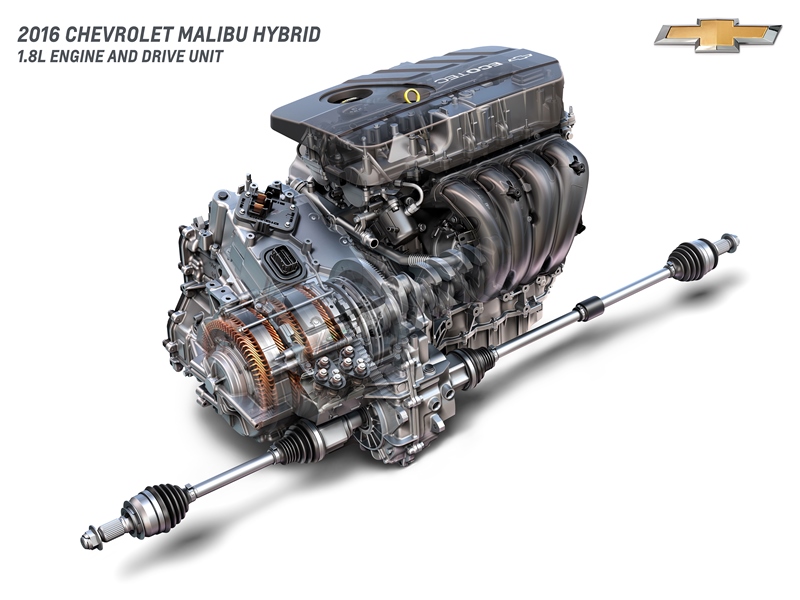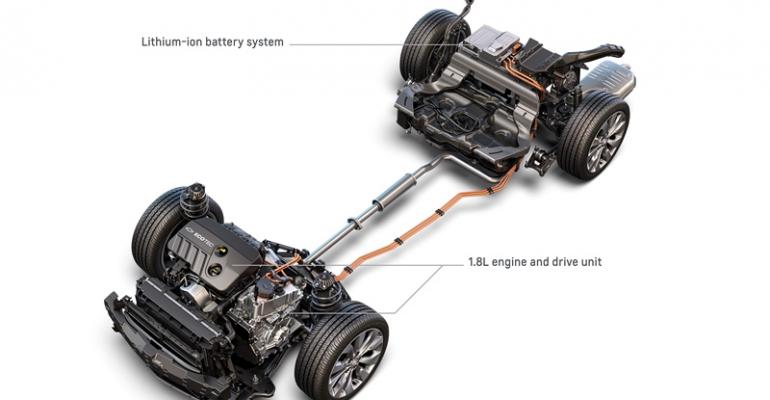MUSCLE SHOALS, AL – The Chevrolet Volt, now in its second generation, has established itself as a respected extended-range electric vehicle, but its peak efficiency lasts about 53 miles (85 km), at which point a gasoline engine kicks in to keep the wheels turning.
The only way to experience that fuel-economy nirvana is to establish a routine of plugging in the Volt every day it’s being driven, and charging via a standard wall socket will require a lot more time than if a 240V Level II charger is available.
So along comes the next logical step for the Chevrolet brand: a parallel hybrid like the Toyota Prius or Ford Fusion that is a lot more efficient than a car driven only by a gasoline engine but has the look, feel and spacious cabin of a standard sedan.
During a 6-hour roundtrip from Nashville to this music-recording promised land, the Chevy Malibu Hybrid is quiet, vibration-free and capable of ascending the hilly terrain of southern Tennessee and northern Alabama without a lick of protest.

Not long ago, cars the size of the new Malibu needed six cylinders of motivation, but this particular segment has been in serious downsizing mode, and 4-cyl. engines now are the norm.
The Malibu Hybrid advances this trend further, pairing a compact 1.8L I-4 with a 2-motor electric drive unit nearly identical to what spins the axles of the new Volt, a 2016 Wards 10 Best Engines winner. General Motors claims an industry first by integrating the power electronics on top of the transmission.
While the Volt is equipped with an all-aluminum 1.5L 4-cyl. rated at 101 hp, the Malibu Hybrid employs a 122-hp 1.8L I-4 with a cast-iron block using the Atkinson combustion cycle. Both engines feature direct fuel injection, but the Volt has a higher compression ratio, 12.5:1 vs. 11.5:1 in the Malibu Hybrid.
HEV Adds 331 lbs. to Malibu
Overall, the Volt is significantly smaller, with a wheelbase 5.3 ins. (135 mm) shorter than the Malibu Hybrid, but the Volt also is 86 lbs. (39 kg) heavier because it has a lot more battery capacity for zero-emission driving.
The Volt uses an 18.4-kWh lithium-ion battery pack, while the Malibu Hybrid makes do with an 80-cell 1.5-kWh Li-ion pack placed behind the backseat. The batteries eat up some of the Malibu’s trunk, but it still has more cargo room than the Volt.
Despite its weight advantage over the Volt, the Malibu Hybrid is a porky 331 lbs. (150 kg) heavier than its comparably equipped non-hybrid sibling.
Combined, the gasoline engine and electric motors produce 182 hp and 277 lb.-ft. (375 Nm) of torque in the Malibu Hybrid, while the battery-rich Volt generates more torque (294 lb.-ft. [398 Nm]) but less horsepower (149). Both vehicles run on regular unleaded fuel.
 At no point does the Malibu Hybrid feel underpowered, but by the same token it’s no sport sedan, either. It does everything a hybrid should do, without calling attention to itself with aerodynamic teardrop styling.
At no point does the Malibu Hybrid feel underpowered, but by the same token it’s no sport sedan, either. It does everything a hybrid should do, without calling attention to itself with aerodynamic teardrop styling.
Chevrolet considers the Ford Fusion HEV to be the Malibu’s primary competitor, although the marketing presentation also identifies hybrid versions of the Hyundai Sonata, Toyota Camry and Honda Accord. The Accord hybrid ended production in ’15, but a new one is due for ’17.
Oddly enough, the ’15 Accord hybrid led the sector with combined fuel economy of 47 mpg (5.0 L/100 km), while the new Malibu Hybrid comes in a hair behind, at 46 mpg (5.1 L/100 km). That’s several mpg better than Fusion, Sonata and Camry.
The Malibu Hybrid uses a clutch system to switch between the gasoline engine and electric motors, optimizing their performance in the city or on the highway.
Real-World Testing Finds 45.7 MPG
Tim Grewe, GM’s director-global electrification, says it’s no coincidence the car’s EPA-rated fuel economy is flat, at 47/46 mpg city/highway. The goal was to avoid peaks and instead deliver uniform efficiency in all driving modes.
Our testing falls a bit short of the EPA ratings, achieving 45.7 mpg (5.1 L/100 km) on the first day of driving and 42.9 mpg (5.4 L/100 km) on the second day, according to the trip computer.
With a light foot, the Malibu Hybrid can top 50 mph (80 km/h) in electric mode. “I’ve been able to hypermile up to 62 mpg (3.8 L/100 km) over 25 miles (40 km) with it,” Grewe boasts. “It can be any kind of car you want it to be.”
Further enhancing efficiency are a variable displacement oil pump, an electrically driven oil pump for the drive unit and Chevrolet’s first application of exhaust-gas heat recovery, which uses exhaust heat to warm the engine and cabin. The system helps the engine reach 600º F (316º C) within three minutes – more quickly than other hybrids, enabling stop/start cycling to occur much sooner.
The car also borrows the Volt’s blended regenerating braking system, which provides maximum kinetic energy recovery during by-wire braking to extend battery range.
 For maximum efficiency, Grewe suggests switching the transmission to “Low” mode to recapture more energy each time you lift off the accelerator pedal. “I personally like driving in low all the time,” he says.
For maximum efficiency, Grewe suggests switching the transmission to “Low” mode to recapture more energy each time you lift off the accelerator pedal. “I personally like driving in low all the time,” he says.
Our testing of low mode for about an hour on the second day of driving didn’t appear to move the needle much in fuel consumption.
Pricing for the Malibu Hybrid starts at $27,700. Consumers sensitive to carbon footprints might find the car will meet their needs, and they might not even mind paying the $2,750 premium over a similarly equipped non-hybrid model for the sake of the planet.
The other 95% of the population will keep buying pickup trucks and larger utility vehicles, happy to take advantage of gas prices hovering near $2 per gallon.
'16 Chevrolet Malibu Hybrid Specifications
| Vehicle type | Front-drive, 4-door, 5-passenger strong-hybrid sedan |
| Engine | 1.8L DOHC direct-injected Atkinson 4-cyl. with cast-iron block/aluminum head |
| Power (SAE net) | 122 hp @ 5,000 rpm |
| Torque | 129 lb.-ft. (175 Nm) @ 4,750 rpm |
| Bore x stroke (mm) | 80.5 x 88.2 |
| Compression ratio | 11.5:1 |
| Transmission | Electric drive unit with planet gear set and integrating two electric motors |
| Total system output | 182 hp |
| Total system torque | 277 lb.-ft. (375 Nm) |
| Curb weight | 3,457 lbs. (1,568 kg) |
| Price as tested | $32,625 |
| EPA fuel economy | 47/46 mpg (5.0-5.1 L/100 km) |
| Competition | Ford Fusion, Honda Accord, Hyundai Sonata, Toyota Camry hybrids |
| Pros | Cons |
|---|---|
| Excellent package, reasonably priced | HEVs aren’t flying out of showrooms |
| Shift to Low mode for better mileage | Tried it and didn’t see much gain |
| 1.8L I-4 works well with twin motors | Why use cast iron for engine block? |





